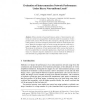Free Online Productivity Tools
i2Speak
i2Symbol
i2OCR
iTex2Img
iWeb2Print
iWeb2Shot
i2Type
iPdf2Split
iPdf2Merge
i2Bopomofo
i2Arabic
i2Style
i2Image
i2PDF
iLatex2Rtf
Sci2ools
101
click to vote
ICA3PP
2005
Springer
2005
Springer
Evaluation of Interconnection Network Performance Under Heavy Non-uniform Loads
Abstract. Many simulation-based performance studies of interconnection networks are carried out using synthetic workloads under the assumption of independent traffic sources. We show that this assumption, although useful for some traffic patterns, can lead to deceptive performance results for loads beyond saturation. Network throughput varies so much amongst the network nodes that average throughput does not reflect anymore network performance as a whole. We propose the utilization of burst synchronized traffic sources that better reflect the coupled behavior of parallel applications at high loads. A performance study of a restrictive injection mechanism is used to illustrate the different results obtained using independent and non-independent traffic sources.
Related Content
| Added | 27 Jun 2010 |
| Updated | 27 Jun 2010 |
| Type | Conference |
| Year | 2005 |
| Where | ICA3PP |
| Authors | Cruz Izu, José Miguel-Alonso, José A. Gregorio |
Comments (0)

